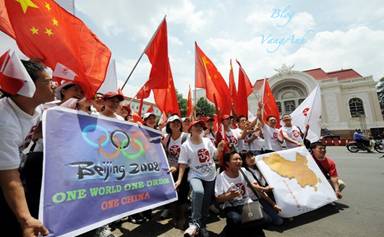CHINA
EXPANSIONISM
GS Nguyen Văn Canh
Bài nói chuyện của GS Nguyễn Văn Canh vào ngày 03.11.2019 tại Spokane, Hoa Kỳ cùng với nhà báo William Jasper
Webmaster:
Là cựu sinh viên Ban Công Pháp của Đại Học Luật
Khoa Sài G̣n trước 30.4.1975, tôi xin giới thiệu đến quư thân
hữu bài nói chuyện của GS Nguyễn Văn Canh, cựu GS ĐHLKSG với
tựa đề China Expansionism bằng Anh Ngữ được tổ chức
vào ngày 03.11.2019 tại Spokane, Hoa Kỳ cùng với kư giả William
Jasper: Mời xem "Trung
Quốc: Mối đe doạ to lớn: Kư
giả William Jasper"
![]()
http://navygermany.gerussa.com/main/diendanbandoc/baivothutin/baibandoc/AChau_TQ_MoiDeDoaToLon.htm
Quư thân hữu có thể xem nhiều bài biên khảo khác của GS Nguyễn Văn Canh liên quan tới biển Đông đă được uploaded lên http://navygermany.gerussa.com trang Hoàng Sa_Trường Sa
Kính
KS Nguyễn Văn Phảy
***
Xin trích thư của GS NV Canh:
Thân gửi anh
Phảy:
Anh update lên
WEB bài của Jasper là tốt. Tôi kèm theo tài liệu
của tôi được sử dụng để nói
chuyện hôm 3 tháng 11, 19 ở Spokane , cùng với Jasper,
để anh up load lên WEB của Anh.
Trong tài
liệu này , có 2 ḍng ở phần kết luận, tôi
có nói tới TC dùng chiến tranh sinh hoá, không cần
đến nguyên tử đánh Mỹ ngay tại Hoa
Thịnh đốn, sẽ gây ra hàng triệu người
chết. Và lúc đó tất cả các nước,
đặc biệt là Tây Âu sẽ đầu hàng. ĐÓ
LÀ THẾ KỶ CỦA NGƯỜI TÀU ( vào năm
2049). Tài liệu này in , màu, rất đẹp. Các anh
em cựu sỹ Quan Cảnh Sát ở San Jose, ở Nam CA
và LS Bích đă gửi cho từng Nghị Sĩ/ Dân
Biểu trong số 539 người tại Hoa Kỳ và
cả cho Hành Pháp nữa. Tôi kèm tài liệu này và anh kêu
gọi anh em ở Đức và Âu Châu, in ra rồi
phổ biến cho Quốc Hội, Hành Pháp để
họ biết. Nhận dịp Vụ Vũ Hán bùng
nổ, th́ tài liệu này có sức mạnh hơn, dù tôi
đă đề cập vấn đề ấy vào năm
2008 và cũng có nói trong cuốn Hồ Sơ Hoàng Sa
& Trường Sa và Chủ Quyền Dân Tộc (
ấn bản I, 2008) .
Thân,
GS Nguyễn văn Canh.
***
CHINA
EXPANSIONISM
GS
Nguyen van Canh
June 17, 2019
Extracted from “Hồ Sơ Hoàng
Sa & Trường Sa và Chủ Quyen Dân Tộc” (Dossiers
on Paracels & Spratlys and National Sovereignty)
by Nguyễn văn Canh *, UBBVSVTLT, 6th
edition, 2017.
Summary:
After defeating Chiang Kai-shek
in 1949, Communist China took power. She released a
9 -dash line map of the South China Sea that included Vietnam’s
Paracels and Spratlys, claiming the 3.5 million km2 sea is hers.
In
January 1974, China sent a
fleet of 41 ships of her naval forces to take
Paracels from the Republic of Vietnam. In March 1988, four destroyers with
heavy weapons attacked unarmed members of Vietnamese engineer corps who were
in the waters, carrying construction materials to South Johnson Reef and
occupied it. 64 out of the 74 men
were killed. At that times, 5 other reefs in
the neighborhood were taken. In 1992, she occupied
others.
Presently,
in Paracels, a large military complex has existed. On Woody island, there is
a large airfield with a 3000m X 250 m runway, and jet fighters have been
deployed. Ammo. and missiles depots are in the North side. Larger sea ports
have been built. A tall communication tower and radars and other facilities
have been in operation. A
large multi-storey building is served
as a military headquarter for the
region. Several hundred solders have been stationed there. On other islands
in the archipelago, military fortified fortresses have been erected.
In
Spratlys, a system of naval bases built on eight artificial islands is found
in the middle of the sea. The three largest and most important are Subi,
Mischief and Fiery Cross, on each of which an
airfield with a 3000m x 250m runway has been completed
to accomodate large aircrafts when landing and taking off. And also
on each, a squadron of 24 long range bombers is being deployed, not
including some most advanced aircraft j-20’s
or long range stealth
fighters . They are combat-ready. Seaports, weapons with missiles and
ammunition depots, advanced infrared sense radar network and communication
facilities, gun emplacements are also detected. Along north sides of Subi
and Fiery Cross, there are underground depots of supplies and materials.
Anti- aircraft and also anti-ship missiles are camouflaged.
China
now can project its military power anywhere in Southeast Asia and as far
away as northern Australia. She is capable of securing the area, including
blocking the Malacca Straits anytime she wants.
With support of Sanya
Naval base in Hainan, China uses Paracels and Spratlys as a staging base
from which she plans to move forward: Claiming
sovereignty over the Western region
of the Pacific and also conquering Southeast Asia countries then annexing
them to China.
*
Dr Nguyen van Canh: Before 1975,
professor of Law & Politics, Saigon Law School; in the USA, Visiting
Scholar, Hoover Institution on Peace, War and Revolution, Stanford
University
SANYA NAVAL BASE IN HAINAN
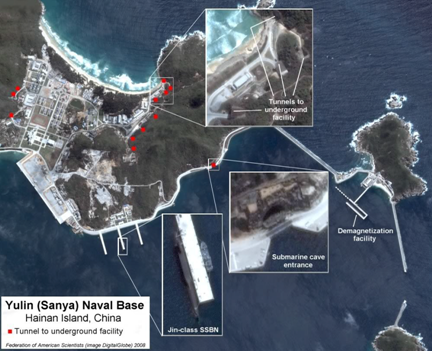
Entrance of a case that houses 20 submarines, type 094
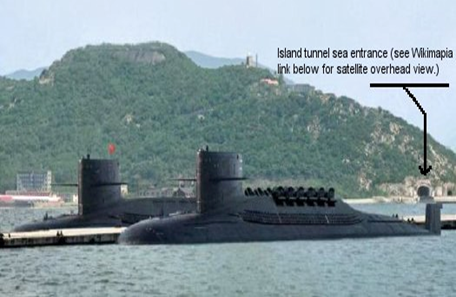
Submarine,
type 094 equipped with 12 long range missiles, (6 on each side)
CLAIMING SOVEREIGNTY
OVER VIETNAM’s SOUTH CHINA
SEA
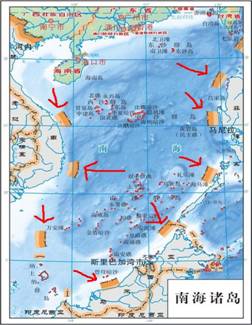
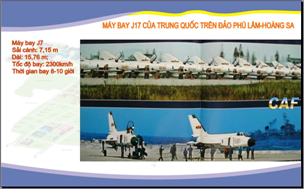
A. PARACELS
Woody Island
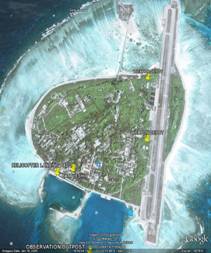
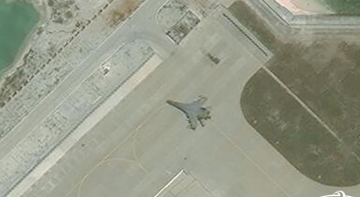 J 7s on Woody
J 7s on Woody
CNN
June 21,19: 4
J 10s seen on Woody;
(range 500 mi )
(CSIS- AMTI/DigitalGlobe)
HEADQUA RTER CHINA’s MILITARY NAVAL FORCES
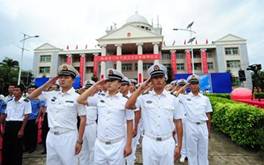
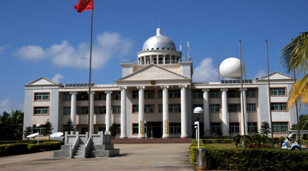
A
system of bases
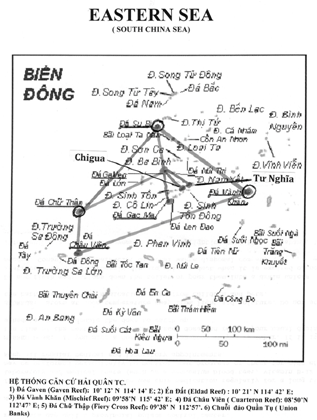 Some
photographs show cargo ships and supply vessels, which the Inquirer said
appeared to be delivering construction materials to the China-controlled
islands. Others show runways,
hangars, control towers, helipads and radomes as well as a
series of multi-storey buildings that China
has built on reefs such as Fiery Cross, Subi,
Mischief, McKennan, Chigua, Johnson South, Gaven and Cuarteron. The Inquirer
described the reefs as “island fortresses”. Bonnie Glaser, an expert in
Asia-Pacific security issues from the Center for Strategic and International
Studies, called the images “the most complete, detailed batch of aerial
pics available” of China’s
military outposts in the South China Sea. A point defense
emplacement was completed in 2016. The guns on the structure are covered up
in the images. A communications tower with accompanying blue radomes is
erected. As on Cuarteron, Gaven, and Hughes Reefs, the tower was built in
2015 and the radomes completed in 2016. A
solar panel array: built in late 2015 or early 2016. Two wind turbines
installed in late 2015. A tall tower housing a sensor/communications
facility topped by a radome, completed in late 2015. There is a large
lighthouse
Some
photographs show cargo ships and supply vessels, which the Inquirer said
appeared to be delivering construction materials to the China-controlled
islands. Others show runways,
hangars, control towers, helipads and radomes as well as a
series of multi-storey buildings that China
has built on reefs such as Fiery Cross, Subi,
Mischief, McKennan, Chigua, Johnson South, Gaven and Cuarteron. The Inquirer
described the reefs as “island fortresses”. Bonnie Glaser, an expert in
Asia-Pacific security issues from the Center for Strategic and International
Studies, called the images “the most complete, detailed batch of aerial
pics available” of China’s
military outposts in the South China Sea. A point defense
emplacement was completed in 2016. The guns on the structure are covered up
in the images. A communications tower with accompanying blue radomes is
erected. As on Cuarteron, Gaven, and Hughes Reefs, the tower was built in
2015 and the radomes completed in 2016. A
solar panel array: built in late 2015 or early 2016. Two wind turbines
installed in late 2015. A tall tower housing a sensor/communications
facility topped by a radome, completed in late 2015. There is a large
lighthouse
FORTIFIED MILITARY
INSTALLATIONS IN SPRATLYS:
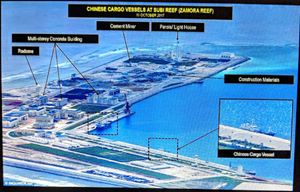
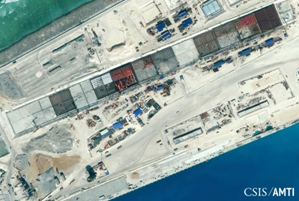
1.
SUBI
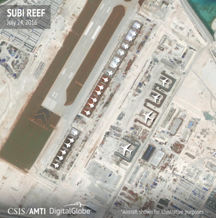
Reuters,
March 20, 2018: 400 buildings have
been constructed; buried storage facilities constructed along thNorth
side of Subi; Runways and hangars
could accommodate H-6K nuclear capable bombers.
2. GAVEN
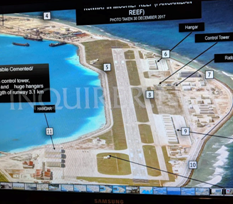
A solar panel array,
constructed in tandem with the administrative building in 2015. The
headquarters/administrative center on Gaven Reefs, built in 2015. The
octagonal structures jutting out from each corner sport gun emplacements,
which are covered up in the aerial Inquirer photos.A
communications tower, with accompanying blue radomes. The tower went up in
2015, followed by the radomes in the first half of 2016. Three of six wind
turbines on Gaven Reefs (the other three can be seen between the
communication tower and administrative building). All six turbines appear to
have been erected in 2015. A tall tower housing a sensor/communications
facility topped by a radome, completed in 2016. Headquarters
built in 2015 wth gun
emplacements, radomes and 6
turbins; Solar Panel on building; a sensor/communications
facility topped by a radome, completed in 201
A sensor/commo facility with radomes, completed in
2017; one of 4 point facilities in 2016; 3 sensor/como. facility with
radomes on top, 2017, underground tunnels (for ammunitions & materials)
, a 3000ft runway with hangar space for 8 combat aircratfs completed 2016; one of five hangars
for larger aircraft; an administrative building a
sesor/communications facility topped
by a radome Hangar space for 16
combat aircrafts (2016)
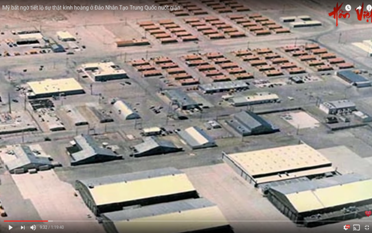
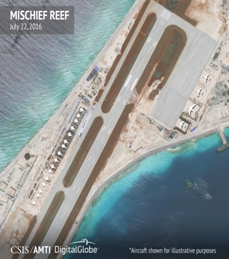
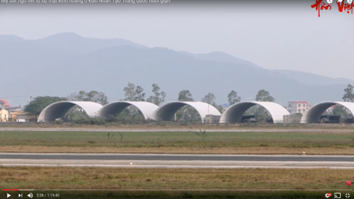
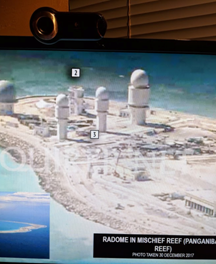
Hangar
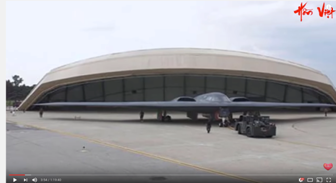
Stealth
& hangar
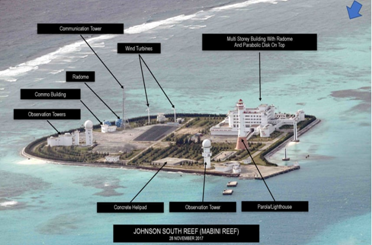 A
commo tower with blue radomes completed in 2016; a solar panel array built
in late 2015; two wind turbines; a tall tower housing a
sensor/communications facility topped by a radome, completed in late 2015; a
large lighthouse; administrative building also completed.
A
commo tower with blue radomes completed in 2016; a solar panel array built
in late 2015; two wind turbines; a tall tower housing a
sensor/communications facility topped by a radome, completed in late 2015; a
large lighthouse; administrative building also completed.
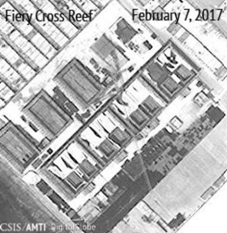
5. FIERY CROSS
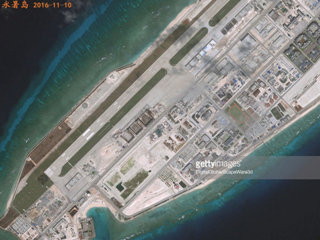
It
costs China 5 billion US dollars to build this fortress
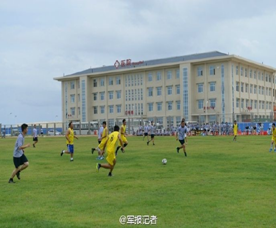
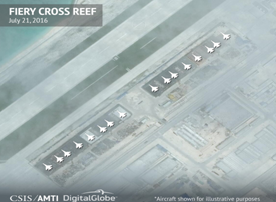
Hospital Headquarter
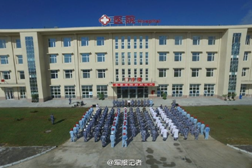
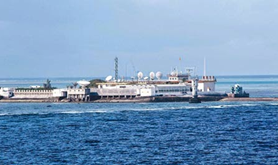
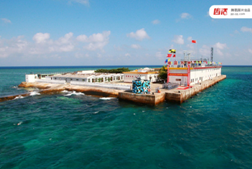
Missiles
launching platform,
-
96 m x 116 m (to shoot down
American
satellites.) No satellites available,
American
aircraft carriers no longer receive guidance, and disorient…
6. CUARTERON REEF
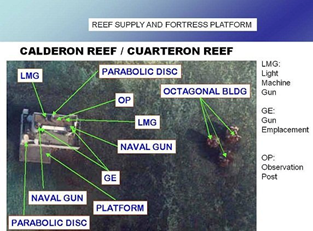
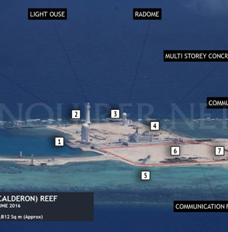 A
tall tower housing sensor/communications facility
with a radome (2016); a lighthouse ( 2015); one of two point defense
emplacements (2016); a large administrative building; a second point defense
emplacement (2016); a large radar array, likelyfor high frequency
over-the-horizon radar. The array consists of a grid of vertical
poles,atellite images taken from directly overhead do a poor job of
depicting the array. A communications tower completed in 2015. The two blue
radomes on the ground
beside the tower in the satellite images do not appear in the aerial photos
and were constructed in 2016
A
tall tower housing sensor/communications facility
with a radome (2016); a lighthouse ( 2015); one of two point defense
emplacements (2016); a large administrative building; a second point defense
emplacement (2016); a large radar array, likelyfor high frequency
over-the-horizon radar. The array consists of a grid of vertical
poles,atellite images taken from directly overhead do a poor job of
depicting the array. A communications tower completed in 2015. The two blue
radomes on the ground
beside the tower in the satellite images do not appear in the aerial photos
and were constructed in 2016
CHINA ‘s SCHEME OF
EXPANSION IN THE REGION
1. Great China 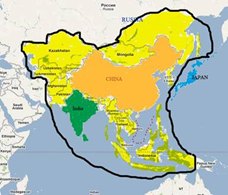 2.
West Region of the Pacific
belongs to China
2.
West Region of the Pacific
belongs to China
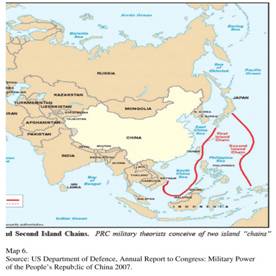
In
order to claim sovereignty over the Western Region of the Pacific, China
Naval forces set up two lines of defense: a)
Chains of islands defense line: from Japan
down to the Philippines; b) far-distant line of defense: from
Indonesia through Guam down to Australia.
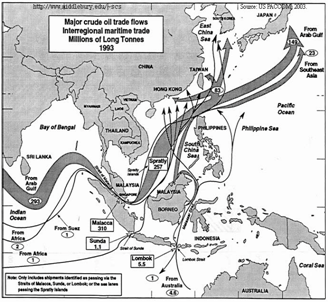 SEA LANE FROM INDIAN
OCEAN TO NORTH EAST OF ASIA
SEA LANE FROM INDIAN
OCEAN TO NORTH EAST OF ASIA
Sea
lane goes from Indian Ocean through Malacca Strait to South China sea, then
North East of Asia. Annual World trade values are estimated at 53,000
billion US dollars. The USA share is $13,000 billion.
Militarily,
China is capable of blocking the Malacca Strait at any time. But she dare
not because she is not strong enough. She could lie in wait, even for 3 or 4
decades to come until she feels she is ready. If
this happens, it will have an unthinkable impact on the US economy, not to
mention about political and other situations in the US.
-----------------------------
Young men and women
sent from China held this banner before the former Republic of Vietnam
National Assembly in 2008, in Saigon, before the Beijing Olympic began.
ONE WORLD ONE DREAM AND ONE CHINA
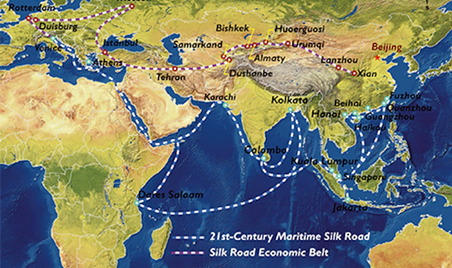
To achieve this goal, China announced the OneBeltOneRoad Initiative (BRI) Strategy with US$ 1,000 billion dollars earmarked for this Expansionism purpose. Li Keqiang, Chinese Premier in a conference on BRI held in Beijing few months ago stated that 126 countries and 29 world organizations have joined the program. The latest country is Italy who recently has adhered to this program since April 2019.
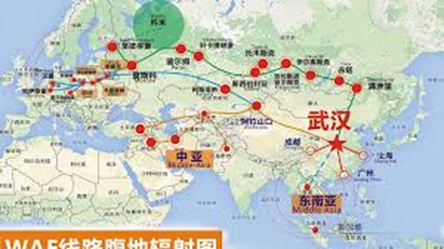
How does this program
work? China State
Bank and “private” Banks loan money to countries that need to develop
their infrastructure such as roads, bridges, railways, seaports, airports
etc… even with easy conditions, even without conditions required. The loan
amount in many cases is more
than $ US 20 billion. When times
come to pay back the loaned money, debtors who are not able to have
resources available to pay back have to make concessions by allowing China
to use strategic areas for a period of 40, 60 or 99 years., where she builds
military installations, or where she has exclusive rights to exploit mineral
resources. This is called debts traps.
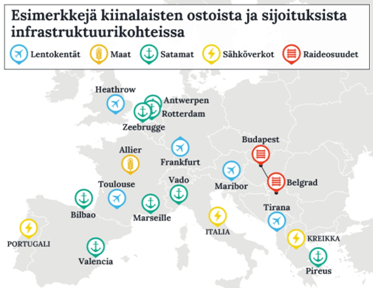 What areas does China
want? Seaports,
airports, areas that sit on the BRI road
What areas does China
want? Seaports,
airports, areas that sit on the BRI road
-In
Asia, seaports are places where China look at. The following countries that
allowed China uses their seaports are
under the conditions, are Sri
Lankra, Myanmar, Bangladesh, Pakistan, Maldives, Teheran…
-In
Africa, areas where there are mineral resources such as gold, copper,
zinc, iron, silver
aluminum etc .. Zimbabwe, Congo, Kenya, Maroc, Nigeria, Djibouti, Angol
, Nambia etc. are examples .
-In
Europe, many countries have received financial aids from China. Italy is an
example. Italy has allowed China to use Trieste in Northern part of Italy.
It is a seaport that lies on the
border of Adriatic sea, leading to the Balkan area, connected with a
railroad leading to Northern and Central Europe. Italy has also agreed to
have China exploit the Geona
port that faces Mediterranean Sea. These are two of 14 European ports which
are operated with money from China. Another Italy ‘s Vado port on the
Mediterranean sea has been conceded to China. Xi Jinping
came to Italy on March 21, 19 and agreed to provide Italy
20 US $
billion. Previously, in 2000, Italy had received from China 14
billion Euros.
Besides,
China has another secret plan. Those countries that received aids from China
are places where China send Chinese in under the name of economic
cooperation and economic aids. This
is the way Chinese slowly build colonies. In Africa, millions of Chinese
from mainland came and have
settled down. In Europe, she bought small farms and Chinese peasants are
seen in many places. It is said that some 30 millions have
been relocated from China. In Beijing, there is an University that
trains young female students militarily with skills to be good wives and
then China export them to Western hemisphere
under the Maosan Plan: to get married with white men, and foster Chinese families for future
use.
The first batch of the program is 1,000, 000 girls.
In
order to achieve what is called CHINA
DREAM, the USA is the main target for attack. China wages a war with
many fronts: economic, monetary, intelligence including
planting agents in R & D of Corporations,
research institutions, universities, propaganda,
cyberwar, exporting young girls to the USA etc. These are just
secondary. The main means to defeat America is bio/chem warfare,
waged at DC, where several million people die, not necessarily using nuclear
warfare.
When the USA collapses, all western countries will surrender.
Here
comes the “CENTURY OF CHINA”.
Mời
xem "Trung
Quốc: Mối đe doạ to lớn: Kư
giả William Jasper"
![]()
http://navygermany.gerussa.com/main/diendanbandoc/baivothutin/baibandoc/AChau_TQ_MoiDeDoaToLon.htm
